Articles
- Page Path
- HOME > Korean J Community Nutr > Volume 16(1); 2011 > Article
-
Original Article
- Effects of a Health Education Program for Elementary School Children in Gyeonggi-do Rural Area
- Jae Yeon Lim, Hye Bock Na
-
Korean Journal of Community Nutrition 2011;16(1):1-13.
DOI: https://doi.org/10.5720/kjcn.2011.16.1.1
Published online: February 28, 2011
Department of Food and Nutrition, College of Natural Sciences, Seoul Women's University, Seoul, Korea.
- Corresponding author: Hye Bock Na, Department of Nutrition, Seoul Women's University, 126 Kongneung 2-dong, Nowon-gu, Seoul 139-144, Korea. Tel: (02) 970-5645, Fax: (02) 976-4049, hbna@swu.ac.kr
Copyright © 2011 The Korean Society of Community Nutrition
- 440 Views
- 0 Download
- 5 Crossref
Abstract
- The purpose of this study was to implement and evaluate the health education program for elementary school children. The program consisted of nutritional education and physical exercise. The subjects composed of 89 school children, first through sixth grade (n = 100), who had completed ten weeks of health education program from April through July 2010. Pre-post intervention design was used to evaluate the program effectiveness. After completing health education program, the number of overweight subjects decreased (boys 13 to 11 and girls 11 to 9) and the number of obese subjects decreased from 5 to 4 for boys and 4 to 2 for girls The number of sit-ups significantly increased in both 1-2 grade girls and 3-4 grade girls. Backward trunk extension of 1-2 grade girls also significantly increased (p < 0.05). The level of serum total cholesterol decreased from 171.8 mg/dL to 153.5 mg/dL (p < 0.001). Hypercholesterolemia (above 239 mg/dL), hyperLDLcholesterolemia (above 175 mg/dL) and low level hemoglobin subjects changed to normal levels. Total score of nutrition knowledge increased from 5.9 to 6.1 (p < 0.05), percentage of perception answers increased significantly in 5 out of 10 items and percentage of correct answers increased significantly in 6 out of 10 items (p < 0.05). Three food habits improved, including, "having breakfast", "having diverse foods" and "having vegetables per meal" (p < 0.05). Two self-efficacy items improved significantly, including, "having meals slowly", "having exercise instead of watching TV or computer" (p < 0.05). These results suggest that health education program for elementary school children including nutritional education and physical exercise may be effective to improve their anthropometric characteristics, physical fitness, hyperlipidemia, nutrition knowledge, food habits and self-efficacy.
- 1. Ahn Y, Ko SY, Kim KW. Evaluation of a nutrition education program for elementary school children. Korean J Community Nutr. 2009; 14(3): 266-276.
- 2. Baek SH. The effect of physical activity on children's obesity. Korean J Obes. 2008; 17(2): 55-64.
- 3. Bandura A. Foundations of thought and action: A social cognitive theory. 1986; Englewood Cliffs, NJ: Prentice-Hall.
- 4. Green LW, Kreuter MW. Health program planning - An educational and ecological approach. 2005; New York: McGraw Hill.
- 5. Hancox RJ, Milne BJ, Poulton R. Association between child and adolescent television viewing and adult health, a longitudinal birth cohort study. Lancet. 2004; 364(9430): 257-262.ArticlePubMed
- 6. Her ES, Lee SG, Park HJ, Lee KH. Effect-evaluation on nutrition education in related curriculums for elementary school children - Focused on change of dietary habits -. Korean J Community Nutr. 2005; 10(6): 795-804.
- 7. Hochbaum GM. Strategies and their rationale for changing people's eating habits. J Nutr Educ. 1981; 13(1): 59-65.Article
- 8. Jung YY, Shin EK, Lee HJ, Lee NH, Chun BY, Ahn MY, Lee YK. Development and evaluation of a nutrition education program on sodium reduction in elementary school students. Korean J Community Nutr. 2009; 14(6): 746-755.
- 9. Kim EK, Choi YS, Cho UH, Chi KA. Childhood Obesity of Elementary School Students in Kangnung and Seoul Areas -Effects of Area and Parental Socio-Economic Status. Korean J Nutr. 2001; 34(2): 198-212.
- 10. Kim KH. Effects of weight control program on food habits, eating behaviors and life habits in obese elementary school children. Korean J Community Nutr. 2009; 14(5): 509-520.
- 11. Koo JO, Lee JW, Choi YS, Kim JH, Lee JH. Life cycle nutrition. 2006; Seoul: Hyoilbooks; 229-231.
- 12. Korea Centers for Disease Control and Prevention. Korea health issue. 2007a; Seoul: Korea Centers for Disease Control and Prevention; 61-64.
- 13. Korea Centers for Disease Control and Prevention. Korean national growth charts. 2007b; Korea Centers for Disease Control and Prevention: Seoul; 8-27.
- 14. Korea Food & Drug Administration. In-depth analysis on the dietary survey of infant, children and adolescents-winter survey. 2008; Seoul: 86-100.
- 15. Lee EJ, Kim KH. Changes of obesity index, serum lipid profiles and nitrient intakes in obese children after the weight control program of nutrition education. Korean J Community Nutr. 2010; 15(1): 61-72.
- 16. Lee HS, Choi JS, Kim WY. Effect of nutrition education for weight control on the dietary behavior, anthropometry, body composition, and the serum levels of adipocytokines in the elementary obese children. Korean J Food Cult. 2005a; 20(3): 323-330.
- 17. Lee YM, Lee MJ, Kim SY. Effects of nutrition education through discretional activities in elementary school - Focused improving nutrition knowledge and dietary habits in 4th-, 5th, and 6th-grade students. J Korean Diet Assoc. 2005b; 11(3): 331-340.
- 18. Lee YS, Lim HS, Ahn HS, Jang NS. Nutrition throughout the life cycle. 2006; Seoul: Kyomunsa; 254-256.
- 19. Lee JY, Lee SY. A comparative study on nutrition knowledge, eating behavior and nutrient intakes for students at elementary schools with and without nutrition education program. J East Asian Soc Diet Life. 2004; 14(6): 561-570.
- 20. Ministry of Health Welfare. National Health and Nutrition Examination. 2006; The 3rd. Seoul: Ministry of Health Welfare; 181.
- 21. Ministry of Health Welfare. Health Investment. 2007 01 26 Seoul.
- 22. Ministry of Health Welfare. 2007 National Health and Nutrition Examination Korea control of disease control & prevention. 2008; Seoul.
- 23. Ministry of Health Welfare. 2008 Health statistics. 2009; Seoul: Ministry of Health Welfare; 48-49.
- 24. Na SY, Ko SY, Eom SH, Kim KW. Intakes and beliefs of vegetables and fruits, self-efficacy, nutrition knowledge, eating behavior of elementary school students in Kyunggi area. Korean J Community Nutr. 2010; 15(3): 329-341.
- 25. Shin EK, Lee HS, Lee YK. Effects of nutrition education program in obese children and their parents-Focus on anthropometric values and serum biochemical index. Korean J Community Nutr. 2004; 9(5): 566-577.
- 26. Shin KO, Yoo YY, Park HS. Study on the eating habits and growth development in Korean preschool children. Korean J Nutr. 2005; 38(6): 455-464.
- 27. Yi BS. Comparative analysis on meal and food preference between non-obese and obese elementary school chidren. Korean J Food Cult. 2007; 22(4): 482-491.
- 28. Yon MY, Hyun TS. Evaluation of nutrition education program for obese children. J Hum Ecol. 2007; 11(2): 143-151.
- 29. Yoon GA. Overweight tracking in primary schoolchildren and analysis of related factors. Korean J Nutr. 2002; 35(1): 69-77.
REFERENCES
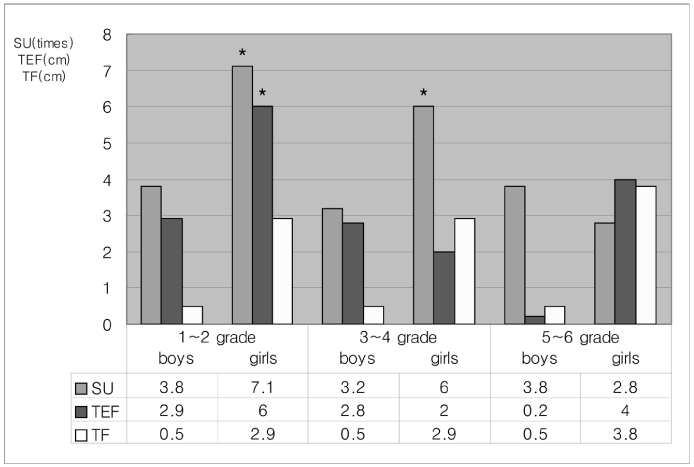
Figure & Data
REFERENCES
Citations

- Effects of Nutrition Education Using Dietary Guidebook in Higher Grade Elementary Students of Jeonbuk Area
Mi-Ran Park, Sook-Bae Kim
Korean Journal of Community Nutrition.2018; 23(1): 13. CrossRef - Effectiveness Evaluation of Food Allergy Education Program for Elementary School Children
Harim Kim, Kyunghee Song, Youngmi Lee, Youngshin Han, Bomi Kang, Soun Ju Kweoun
Journal of the East Asian Society of Dietary Life.2015; 25(6): 1058. CrossRef - Effects of Dietary Education on Elementary Children in After-school Program in Seoul
Kyung-Hee Kim
Journal of the Korean Society of Food Culture.2014; 29(2): 222. CrossRef - Perception on Nutrition Labeling of the Processed Food among Elementary School Students and Parents in Daegu Area
Jung Mi Kim, Mi Hee Lee, Nan Hee Lee
The Korean Journal of Food And Nutrition.2014; 27(6): 1107. CrossRef - Relationships between Eating Behavior, Dietary Self-Efficacy, and Nutrition Knowledge of Elementary School Students by Food Service Type in Gangwon Province
Hyang-Rye Won, Gi-Beum Shin
Journal of the Korean Society of Food Science and Nutrition.2012; 41(5): 638. CrossRef
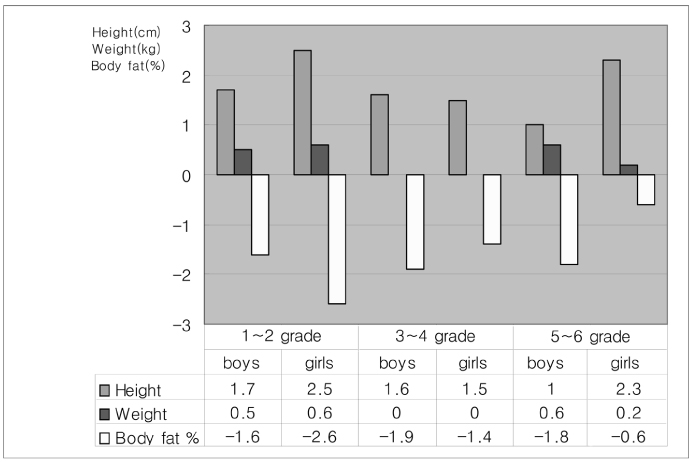

Fig. 1
Fig. 2
Contents of health education program
Distribution of subjects
1) N (%)
Anthropometric characteristics of subjects before health education
1) BMI(Body Mass Index) : weight(kg)/height (m)2
2) Mean ± SD
*: p < 0.05, **: p < 0.01, ***: p < 0.001 by t-test between boys and girls
Physical fitness of subjects before health education
1) Mean ± SD
*: p < 0.05 by t-test between boys and girls
Changes of obesity after health education program
1) N (%)
Changes of serum biochemical levels after health education program
1) Mean ± SD
***: p < 0.001 by t-test
Changes of abnormal serum biochemical levels after health education program
1) N
Changes of nutrition knowledge of subjects after health education program
Knowledge (0 - 1): correct answer 1, don't know and wrong answer 0
1) %
2) *: p < 0.05, **: p < 0.01 by Chi-square test
3) Mean ± SD
4) *: p < 0.05 by t-test
Changes of food habits of subjects after health education program
Score (1 - 4) : 6 - 7days per week 4, 3 - 5days per week 3, 1 - 2days per week, 0 day per week 0
1) Mean ± SD
*: p < 0.05 by t-test
Changes of self-efficacy of subjects after health education program
Score (1 - 4) : strong disagree 1, disagree 2, agree 3, strong agree 4
1) Mean ± SD
*: p < 0.05 by t-test
1) N (%)
1) BMI(Body Mass Index) : weight(kg)/height (m)2 2) Mean ± SD *: p < 0.05, **: p < 0.01, ***: p < 0.001 by t-test between boys and girls
1) Mean ± SD *: p < 0.05 by t-test between boys and girls
1) N (%)
1) Mean ± SD ***: p < 0.001 by t-test
1) N
Knowledge (0 - 1): correct answer 1, don't know and wrong answer 0 1) % 2) *: p < 0.05, **: p < 0.01 by Chi-square test 3) Mean ± SD 4) *: p < 0.05 by t-test
Score (1 - 4) : 6 - 7days per week 4, 3 - 5days per week 3, 1 - 2days per week, 0 day per week 0 1) Mean ± SD *: p < 0.05 by t-test
Score (1 - 4) : strong disagree 1, disagree 2, agree 3, strong agree 4 1) Mean ± SD *: p < 0.05 by t-test

 KSCN
KSCN






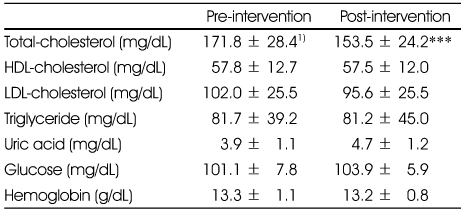
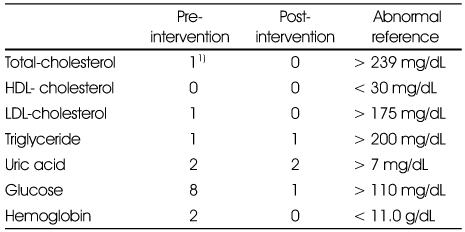


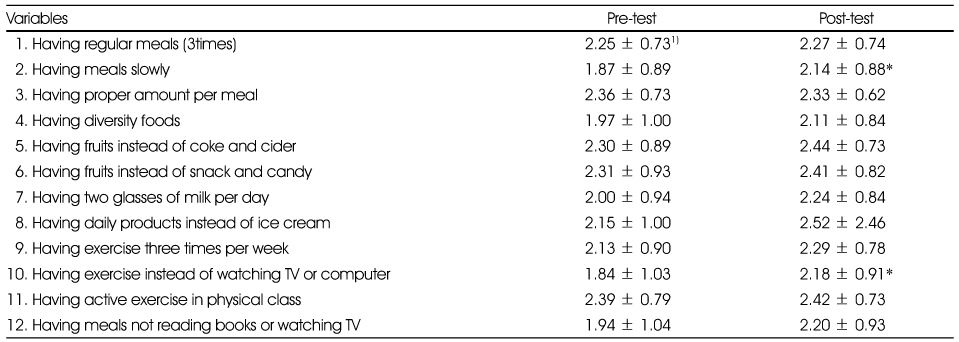
 PubReader
PubReader Cite
Cite


